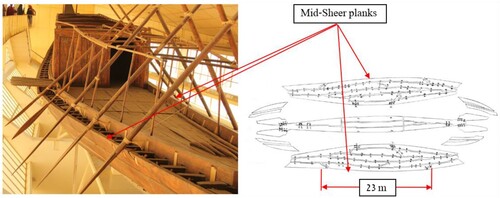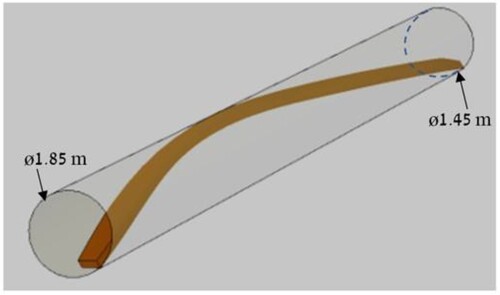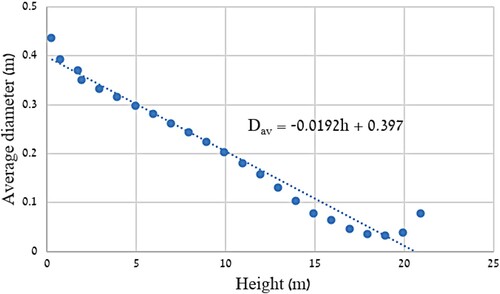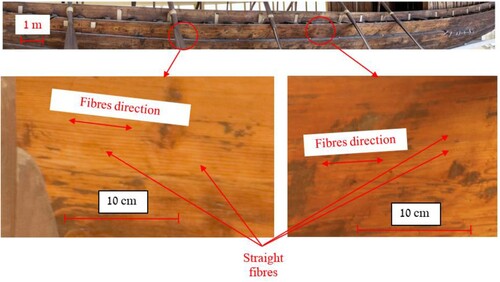 ?Mathematical formulae have been encoded as MathML and are displayed in this HTML version using MathJax in order to improve their display. Uncheck the box to turn MathJax off. This feature requires Javascript. Click on a formula to zoom.
?Mathematical formulae have been encoded as MathML and are displayed in this HTML version using MathJax in order to improve their display. Uncheck the box to turn MathJax off. This feature requires Javascript. Click on a formula to zoom.ABSTRACT
The unassembled components of the Khufu-1 ship, dated to the mid-3rd millennium BC were found in 1954 just south of the Khufu pyramid in Egypt. It has two mid-sheer planks, one on each side: 23 m long, and a maximum of 40 cm wide and 14 cm thick. These planks were made from the cedar of Lebanon (Cedrus libani) imported from Lebanon, 320 Nautical Miles (600 km) away, along the eastern coast of the Mediterranean. According to scholars who studied this ship, the ship planks, which were curved in three dimensions, to fit the hull, were produced from the cedar trunk by carving, not by bending. Given that cedar wood was imported and expensive in Egypt, the choice of the carving technique was unexpected, and above all, would yield a plank weaker than one twisted and bent from a straight timber. The two production techniques (carving and bending) were compared, and it was found that bending was superior, and in fact, was demonstrated to be the actual method of shaping the planks of the Khufu-1 ship.
Introduction
The Khufu-1 ship (), found in 1954, just south of the Khufu pyramid in Egypt, was dated to the mid-3rd millennium BC (Lipke Citation1984). The Khufu-2 ship was found in a stone pit, a few meters west of Khufu-1. It is still being researched but nothing has been published yet.
Khufu-1 unassembled components were buried in a stone pit, and a restoration team, led by Hag Ahmed Youssef Moustafa, of the Egyptian Ministry of Antiquities, assembled it over the following 15 years. This impressive 43 m-long ship is now on display in the new Museum of Archaeology (GEM) in Cairo, Egypt.
Khufu-1 has two mid-sheer planks, one on each side: 23 m long, maximum 40 cm wide, and 14 cm thick (Lipke Citation1984) (). These timbers were made from cedar of Lebanon imported from Lebanon, most probably by sea, 320 Nautical Miles (600 km) away along the eastern coast of the Mediterranean to the eastern Nile estuary, and then south along the Nile to Giza. The planks were found curved in three dimensions to fit the hull shape but not sufficiently curved. To fit them back to the curvature required for their location on the hull, a three weeks’ long process of mechanical-hydro-thermal treatment was carried out (Lipke Citation1984). Cedar of Lebanon was used in the Middle east and particularly in the Egyptian culture throughout history for building prestigious structures (Bible, Gilgamesh, Wenamun trip) and for the production of furniture, coffins, and ships, and was considered a prestigious raw material (Pulak Citation2001, Liphschitz Citation2012).
According to Ward (Citation2004) and Steffy (Citation1994) who studied this ship, these planks were produced from the cedar trunk by carving, not by bending. While looking at the photos of the planks, we began to suspect that the technique of carving them looked a bit strange.
This study was intended to determine whether the mid-sheer planks of the Khufu-1 ship were bent from a straight plank or carved from a trunk.
It is expected that a ship-plank of this shape should be bent for the following reasons:
Less wood wasted.
The strength of the wood is not compromised, compared to the carving technique where wood fibers are cut.
The trunk size that should nest the required plank shape might be impossible or difficult to find.
The technique of bending wood was practiced in ancient Egypt back in the twenty-fifth century BC where wood was heated over a pot of boiled water and then bent to the shape of a bow (Newberry Citation1893) and chariot wheels were bent back in the fourteenth century BC (Navi and Sandberg Citation2012).
The methods of the research
Two methods were used to confirm whether the mid-sheer planks of the Khufu-1 ship were carved to shape from a trunk:
The shape of a typical cedar of Lebanon trunk was estimated, based on actual measurements of standing cedar of Lebanon trees coupled with a formula developed by West (Citation2015). The trunk size required to provide a carved, curved plank of the required dimensions was then calculated using 3D SOLIDWORKS® software ().
The actual mid-sheer plank of the Khufu-1 ship was examined to establish its 3D grain pattern.
Determining the size of a trunk required to nest the curved sheer plank
Assuming that the original trunk used to produce such planks was straight, the relation between the diameter of a tree trunk and the height above ground of the segment of the trunk having that diameter is estimated by the following formula (West Citation2015):
(1)
(1) where doh is the trunk diameter over bark (cm) at height h (m) above ground; D is the trunk diameter at chest height over bark (cm); h is the height (m) at which the diameter is calculated (m); H is the total tree height (m). a1, a2, and b1 thru b4 and I1, I2 are parameters. The specific values for various tree types, including the Cedrus libani, are given in . I1 = 1 when (h/H) ≤ a1 or 0 otherwise. I2 = 1 when (h/H) ≤ a2 or 0 otherwise.
Table 1. Parameters to be used to calculate the relation between diameter and height in various types of tree species (West Citation2015).
To calculate the cone angle of a cedar of Lebanon trunk, 44 cedar of Lebanon trees, 56 years old, were measured by a professional surveyor with standard equipment (Robotic Total Station S3). In each tree, the following dimensions were taken: Total height (H), diameter at breast height (D) two other diameters (doh), and the exact heights (h) for these diameters. Once the formula was established, each tree's diameter at every 1 m height was calculated. The results were averaged and plotted on an x-y diagram and an approximated linear trend line was offered, defining the average, representative trunk cone. To check how close this formula is to reality; diameters were calculated for measured heights using the established formula. These were compared to actual diameters (doh) measured for these heights. The agreement was between 0.7% and 4.2%.
Results
The trend line of this curve (), defines a cone with a full angle of 1.1° which was generated by 3D CAD Solidworks software.
The results show that the base diameter of a trunk required to nest the mid-sheer plank of Khufu-1 in its curved shape was 1.85 m (), while the maximum known diameter of a cedar of Lebanon trunk grown in Lebanon is 2.40 m (Pulak Citation2001). This means that it was probably possible to find a tree with a trunk thick enough for carving the plank from it.
New data were released regarding the structure of the Khufu-2 ship: It has a cedar beam 35 meters long! (Yoshimura Citation2022). The cross-section of the beam and its geometry have not been published yet, but it is assumed that running the above calculations on that newly released beam would yield a trunk diameter bigger than 2.40 m.
The grain pattern of the mid-sheer plank of the Khufu-1 ship illustrates the method by which it was produced from the trunk. There is a significant difference between the grain pattern of a beam that was carved along the fibers and a beam that was carved at an angle to the fibers’ direction. This difference is demonstrated in :
Figure 4. A trunk sawn in different orientations in relation to the main direction of a tree (Photo: M. Bram).

This Calabrian pine (Pinus brutia) timber was cut in three ways:
Cut along the grain, showing straight lines.
Cut across the grain, showing circular rings.
Cut diagonally to the grain, showing semi-elliptical rings.
Should a strait trunk be cut in order to get a curved twisted shape, there would be some traces of diagonal cuts which look like semi-elliptical rings.
Obviously, bending the beam does not change the pattern of the fibers. Close examination of the grain pattern in a photomosaic () of the Khufu-1 ship, created from photos taken at the Solar Boat Museum in Egypt, shows that the curved plank with a straight grain that is lined with the plank length, meaning that the plank was most probably bent and not carved.
Discussion
The carving technique has two disadvantages compared to bending: a large amount of the wood is wasted () and the strength of the plank is compromised due to cutting across the grain (). It is well-known that wood in general is strongest in the longitudinal direction.
These two arguments can be refuted by two other arguments:
Waste of expensive cedar of Lebanon wood was not important, as this was a no-expenses-spared project and economy was not a factor.
Relating to the argument of compromising the strength due to cutting across the grain, the Khufu-1 ship has no mast, sail, or other propulsion system (Lipke Citation1984), she was a barge, probably towed from the riverbank or by another ship (Khufu-2?) and not required to carry any significant load. She was designed to ride the calm Nile waters, so her hull was not loaded, and, the main load was her own weight. Thus, the vessel’s timbers were not heavily loaded, and the reduced strength of the sheer planks would not affect its ability to accommodate the minor expected load.
Producing beams out of a trunk
Straight beams can be produced by cleaving or sawing. However, only short saws were depicted in Egyptian wall reliefs dated to the fifteenth century BCE (Davies Citation1973), and these were too short to cut a curved plank from the trunk. Larger saws, like the pit saw or frame saw (Goodman Citation1964) were introduced by the Romans only at about 50 BCE (Nicholson and Shaw Citation2000).
A solution for the too-short saw problem could have come from the Egyptian stone industry dated to the twenty-fourth–twenty-fifth centuries BCE, where long saws for cutting huge slabs of stone were used. These saws had no teeth: they were made from copper or bronze, and sand was fed into the cut as an abrasive agent (Moores Citation1991). There is a possibility (no evidence yet) that this technique was copied and altered (by adding saw teeth) by shipwrights. According to the above, curved beams could not be sawn, if not bent, they could be produced by carving and/or hewing.
Still, another possibility is that the trunk, from which the plank was produced, was not a straight one, but bent originally during its growth. As yet, there is no proof, or even – indication, that such a technique was actually used.
Bending a straight beam
The technique of bending wood is well known and was even practiced in ancient Egypt in the twenty-fifth century BCE (Newberry Citation1893) and the fourteenth century BCE (Navi and Sandberg Citation2012).
During the reconstruction of the Khufu-1 ship, managed and done by Hag Ahmed Youssef Moustafa, bending of the original starboard sheer plank was practiced to fit it into the suggested reconstruction design. It was vital, since the planks lost their original curvature during the time they waited in their safe-box. This was done using boiled water poured on it while a bending and torque moment was applied to it (Lipke Citation1984).
Conclusions
The question of whether the two mid-sheer planks of the Khufu-1 ship were carved from a trunk or bent from a straight beam was addressed in two ways: 1. Based on measuring the size of cedar of Lebanon trees, calculating the taper of the trunk, using a formula derived for US cedars, while validating the data against real cedar of Lebanon standing. Then, checking if the size of a possible trunk was large enough to accommodate the complete, curved trunk. 2. Examination of the grain pattern of the actual mid-sheer planks of the Solar Boat in the museum in Egypt. The first indicated that the minimum trunk base diameter that can nest the curved mid-sheer plank is 1.85 m, which was available since the maximum base diameter of cedar of Lebanon trees is about 2.40 m.
The thorough examination of the actual mid-sheer plank of the Khufu-1 ship in the Museum proved that it was twisted and bent from a straight plank, and not carved. This observation relaxes the size requirements for the selection of the cedar of Lebanon trunk and much thinner (younger) trunks (∼90 cm base diameter) could be used, even for the larger beams required for this boat.
It could well be that the boat was not originally designed to have such long planks, but since they were already extracted from the available trunks, or even brought to Egypt having these sizes, they were included in the final version of the design.
Acknowledgements
The authors would like to thank N. Helfman for his technical help.
Disclosure statement
No potential conflict of interest was reported by the author(s).
References
- Davies, N.D., 1973. The rock tombs of Deir el Gebrawi. New York: Egypt Exploration Fund.
- Goodman, W.L., 1964. The history of woodworking tools. London: G. Bell and Sons ltd.
- Liphschitz, N., 2012. The use of Lebanese cedar for ship construction. Evidence from timber identification of Shipwrecks in the East Mediterranean. Skyllis, 1, 94–98.
- Lipke, P., 1984. The royal ship of Cheops, Greenwich. National Maritime Museum, Greenwich, Archaeological Series, 9.
- Moores, R.G., 1991. Evidence for use of a stone-cutting drag saw by the fourth dynasty Egyptians. Journal of the American Research Center in Egypt, 28, 139–148.
- Navi, P., and Sandberg, D., 2012. Thermo-hydro-mechanical processing of wood. Boca Raton, FL: Taylor & Francis Group.
- Newberry, P.E., 1893. Beni Hasan (Part I). London: Kegan Paul, Trench, Trübner & Co.
- Nicholson, P.T., and Shaw, J., 2000. Ancient Egyptian materials and technology. Cambridge: Cambridge University Press.
- Pulak, C., 2001. Cedar for ships. Archaeology and History in Lebanon, 14, 24–36.
- Steffy, J.R., 1994. Wooden shipbuilding and the interpretation of shipwrecks. College Station: Texas A&M University Press.
- Ward, C., 2004. Boat building in ancient Egypt. In: F.M. Hocker and C. Ward, eds. The philosophy of shipbuilding: conceptual approaches to the study of wooden ships. College Station, 13–25.
- West, P.W., 2015. Tree and forest measurement. 3rd ed. Springer International Publishing.
- Yoshimura, K., 2022. A comparative study between Khufu’s first and second boats in respect of their materials, archaeological conditions, and conservation. Master's Thesis Dissertation.




